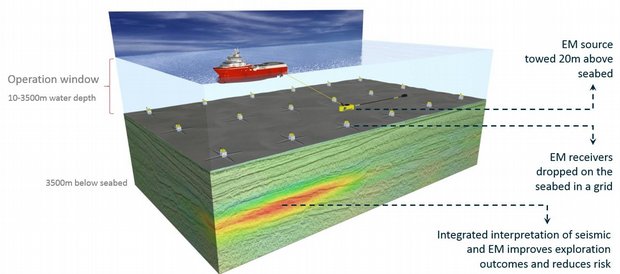CONTROLLED SOURCE ELECTROMAGNETICS (CSEM)
CSEM (Controlled Source ElectroMagnetics) is a geophysical measurement technology commercially introduced to the oil and gas industry in 2002. This technology measures the resistivity distribution in the subsurface, with hydrocarbon filled reservoirs representing a very pronounced resistor which stands out against the general geology in sedimentary basins. By combining CSEM data (sensitive to resistivity and thereby hydrocarbon saturation) with seismic data (primarily provides structural and lithology information), a more efficient de-risking of prospects can be achieved.
CSEM measures resistivity in the subsurface : the larger the resistive body, the greater the response with electrical resistivity = strong correlation with the fluid content and saturation of hydrocarbon reservoirs.
It has a high level of sensitivity to saturation (seal and charge) and net rock volume of reservoir.

WHY CSEM?
Since its introduction, large advancements in CSEM technology have significantly expanded the application window, making it ready for large scale deployment of prospectivity screening.
This has the potential to address two of the main uncertainties which stymie the exploration industry at large: [insert my comparison table]
- With seismic methods being largely insensitive to the hydrocarbon saturation level, discovery success rates are low due to insufficient characterisation of the reservoir fluid fill. By providing additional information on the likely saturation level, significant improvements of the success rate can be achieved.
- A lack of ability to characterise the volume of potential hydrocarbon accumulations further aggravates the challenge of low success rates, with commercial success rates being a fraction of technical success rates. By delimiting the size of a subsurface feature based on its resistivity character, a good appreciation of the potential hydrocarbon volumes can be obtained. This will yield a convergence of technical and commercial success rates.
By utilising these properties, and deploying CSEM early in the exploration work flow, the risk-reward profile for an exploration area can be effectively re-assessed and resources prioritised towards the most promising opportunities. This allows Legend Petroleum to review areas for exploration where previous seismic-focused exploration programmes have proven unsuccessful in identifying opportunities with an acceptable risk-reward profile.
